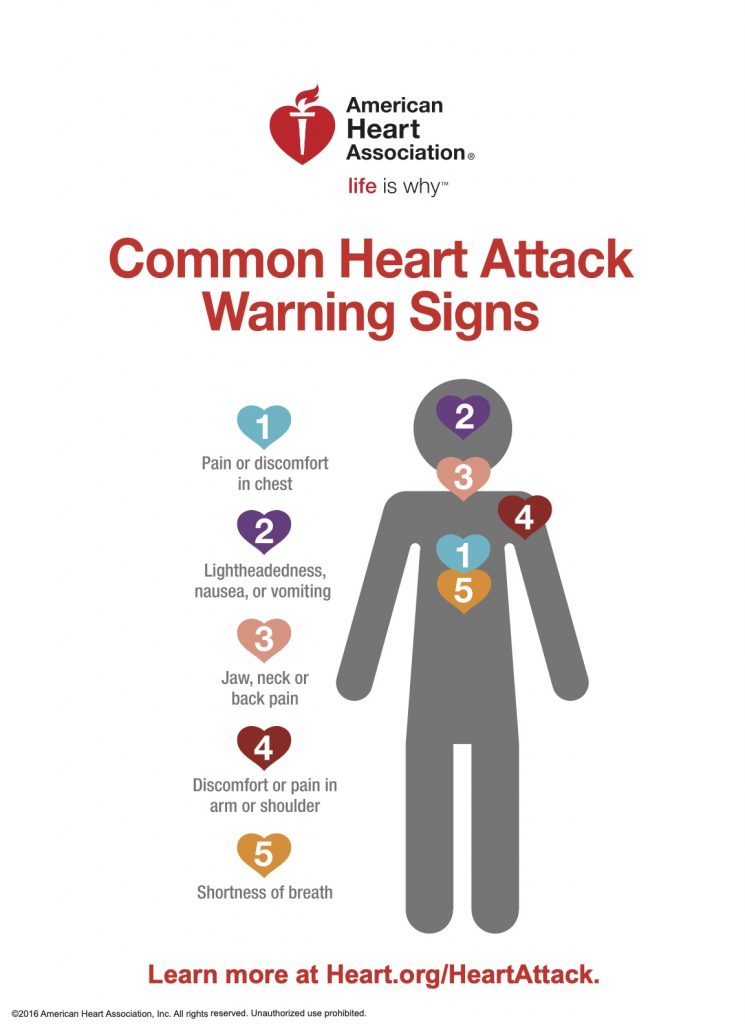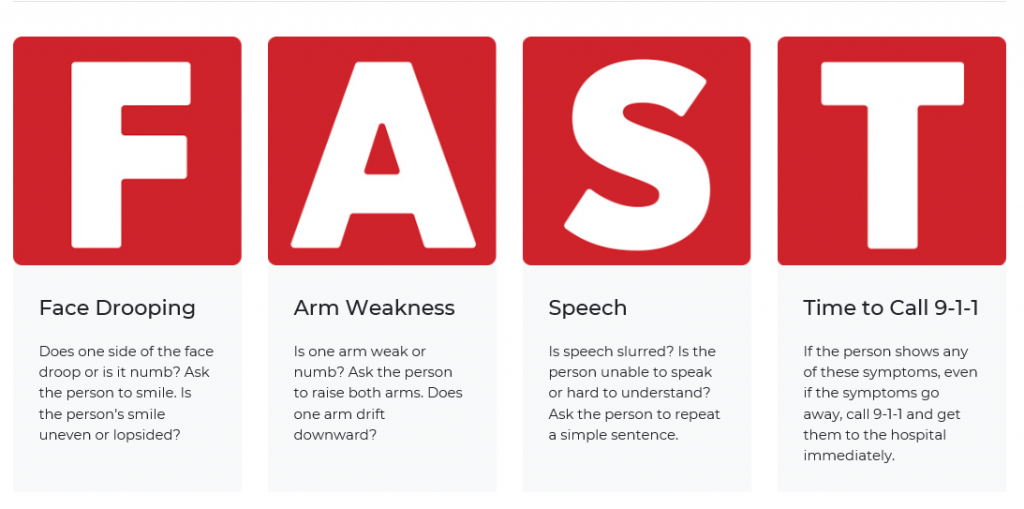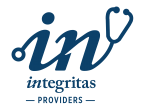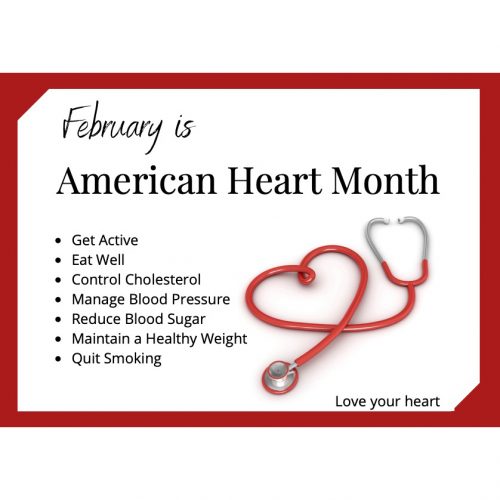Heart disease is the leading cause of death in the U.S. Know your risk and protect your heart.

Heart Attack Symptoms
Heart Attack and Stroke Symptoms | American Heart Association
CHEST DISCOMFORT
Most heart attacks involve discomfort in the center of the chest that lasts more than a few minutes, or that goes away and comes back. It can feel like uncomfortable pressure, squeezing, fullness or pain.
DISCOMFORT IN OTHER AREAS OF THE UPPER BODY
Symptoms can include pain or discomfort in one or both arms, the back, neck, jaw or stomach.
SHORTNESS OF BREATH
with or without chest discomfort.
OTHER SIGNS
may include breaking out in a cold sweat, nausea or lightheadedness.
If you have any of these signs, call 9-1-1 and get to a hospital right away.
- Uncomfortable pressure, squeezing, fullness or pain in the center of your chest. It lasts more than a few minutes, or goes away and comes back.
- Pain or discomfort in one or both arms, the back, neck, jaw or stomach.
- Shortness of breath with or without chest discomfort.
- Other signs such as breaking out in a cold sweat, nausea or lightheadedness.
- As with men, women’s most common heart attack symptom is chest pain or discomfort. But women are somewhat more likely than men to experience some of the other common symptoms, particularly shortness of breath, nausea/vomiting and back or jaw pain.
Heart Attack Symptoms in Women | American Heart Association
“Although men and women can experience chest pressure that feels like an elephant sitting across the chest, women can experience a heart attack without chest pressure, ” said Nieca Goldberg, M.D., medical director for the Joan H. Tisch Center for Women’s Health at NYU’s Langone Medical Center and an American Heart Association volunteer. “Instead they may experience shortness of breath, pressure or pain in the lower chest or upper abdomen, dizziness, lightheadedness or fainting, upper back pressure or extreme fatigue.”
Even when the signs are subtle, the consequences can be deadly, especially if the victim doesn’t get help right away.
‘I thought I had the flu’
Even though heart disease is the No. 1 killer of women in the United States, women often chalk up the symptoms to less life-threatening conditions like acid reflux, the flu or normal aging.
“They do this because they are scared and because they put their families first,” Goldberg said. “There are still many women who are shocked that they could be having a heart attack.”

A heart attack strikes someone about every 43 seconds. It occurs when the blood flow that brings oxygen to the heart muscle is severely reduced or cut off completely. This happens because the arteries that supply the heart with blood can slowly narrow from a buildup of fat, cholesterol and other substances (plaque).
Watch an animation of a heart attack.
Many women think the signs of a heart attack are unmistakable — the image of the elephant comes to mind — but in fact they can be subtler and sometimes confusing.
You could feel so short of breath, “as though you ran a marathon, but you haven’t made a move,” Goldberg said.
Some women experiencing a heart attack describe upper back pressure that feels like squeezing or a rope being tied around them, Goldberg said. Dizziness, lightheadedness or actually fainting are other symptoms to look for.
“Many women I see take an aspirin if they think they are having a heart attack and never call 911,” Goldberg said. “But if they think about taking an aspirin for their heart attack, they should also call 911.”
Take care of yourself
Heart disease is preventable. Here are Goldberg’s top tips:
- Schedule an appointment with your healthcare provider to learn your personal risk for heart disease.
- Quit smoking. Did you know that just one year after you quit, you’ll cut your risk of coronary heart disease by 50 percent?
- Start an exercise program. Just walking 30 minutes a day can lower your risk for heart attack and stroke.
- Modify your family’s diet if needed. Check out these healthy cooking tips. You’ll learn smart substitutions, healthy snacking ideas and better prep methods. For example, with poultry, use the leaner light meat (breasts) instead of the fattier dark meat (legs and thighs), and be sure to remove the skin.
Stroke Symptoms | American Stroke Association
Stroke Symptoms
By learning and sharing the F.A.S.T. warning signs, you just might save a life from stroke.
Use the letters in “F.A.S.T.” to spot stroke signs and know when to call 9-1-1.

Sudden Numbness: Sudden NUMBNESS or weakness of face, arm, or leg, especially on one side of the body
Sudden Confusion: Sudden CONFUSION, trouble speaking or understanding speech
Sudden Trouble Seeing:Sudden TROUBLE SEEING in one or both eyes
Sudden Trouble Walking:Sudden TROUBLE WALKING, dizziness, loss of balance or coordination
Sudden Severe Headache:Sudden SEVERE HEADACHE with no known cause
Hypertension Guideline Resources | American Heart Association
Hypertension
What do your blood pressure numbers mean?
The only way to know if you have high blood pressure (HBP, or hypertension) is to have your blood pressure tested. Understanding your results is key to controlling high blood pressure.
Healthy and unhealthy blood pressure ranges
Learn what’s considered normal, as recommended by the American Heart Association.
| BLOOD PRESSURE CATEGORY | SYSTOLIC mm Hg (upper number) | DIASTOLIC mm Hg (lower number) | |
|---|---|---|---|
| NORMAL | LESS THAN 120 | and | LESS THAN 80 |
| ELEVATED | 120 – 129 | and | LESS THAN 80 |
| HIGH BLOOD PRESSURE (HYPERTENSION) STAGE 1 | 130 – 139 | or | 80 – 89 |
| HIGH BLOOD PRESSURE (HYPERTENSION) STAGE 2 | 140 OR HIGHER | or | 90 OR HIGHER |
| HYPERTENSIVE CRISIS (consult your doctor immediately) | HIGHER THAN 180 | and/or | HIGHER THAN 120 |
Download this chart: English Jpeg | English PDF
Note: A diagnosis of high blood pressure must be confirmed with a medical professional. A doctor should also evaluate any unusually low blood pressure readings.
Understanding Blood Pressure Readings | American Heart Association
Blood pressure categories
The five blood pressure ranges as recognized by the American Heart Association are:
Normal
Blood pressure numbers of less than 120/80 mm Hg are considered within the normal range. If your results fall into this category, stick with heart-healthy habits like following a balanced diet and getting regular exercise.
Elevated
Elevated blood pressure is when readings consistently range from 120-129 systolic and less than 80 mm Hg diastolic. People with elevated blood pressure are likely to develop high blood pressure unless steps are taken to control the condition.
Hypertension Stage 1
Hypertension Stage 1 is when blood pressure consistently ranges from 130-139 systolic or 80-89 mm Hg diastolic. At this stage of high blood pressure, doctors are likely to prescribe lifestyle changes and may consider adding blood pressure medication based on your risk of atherosclerotic cardiovascular disease (ASCVD), such as heart attack or stroke.
Hypertension Stage 2
Hypertension Stage 2 is when blood pressure consistently ranges at 140/90 mm Hg or higher. At this stage of high blood pressure, doctors are likely to prescribe a combination of blood pressure medications and lifestyle changes.
Hypertensive crisis
This stage of high blood pressure requires medical attention. If your blood pressure readings suddenly exceed 180/120 mm Hg, wait five minutes and then test your blood pressure again. If your readings are still unusually high, contact your doctor immediately. You could be experiencing a hypertensive crisis.
If your blood pressure is higher than 180/120 mm Hg and you are experiencing signs of possible organ damage such as chest pain, shortness of breath, back pain, numbness/weakness, change in vision or difficulty speaking, do not wait to see if your pressure comes down on its own. Call 911.
Your blood pressure numbers and what they mean
Your blood pressure is recorded as two numbers:
- Systolic blood pressure (the first number) – indicates how much pressure your blood is exerting against your artery walls when the heart beats.
- Diastolic blood pressure (the second number) – indicates how much pressure your blood is exerting against your artery walls while the heart is resting between beats.
Which number is more important?
Typically, more attention is given to systolic blood pressure (the first number) as a major risk factor for cardiovascular disease for people over 50. In most people, systolic blood pressure rises steadily with age due to the increasing stiffness of large arteries, long-term buildup of plaque and an increased incidence of cardiac and vascular disease.
However, either an elevated systolic or an elevated diastolic blood pressure reading may be used to make a diagnosis of high blood pressure. According to recent studies, the risk of death from ischemic heart disease and stroke doubles with every 20 mm Hg systolic or 10 mm Hg diastolic increase among people from age 40 to 89.


